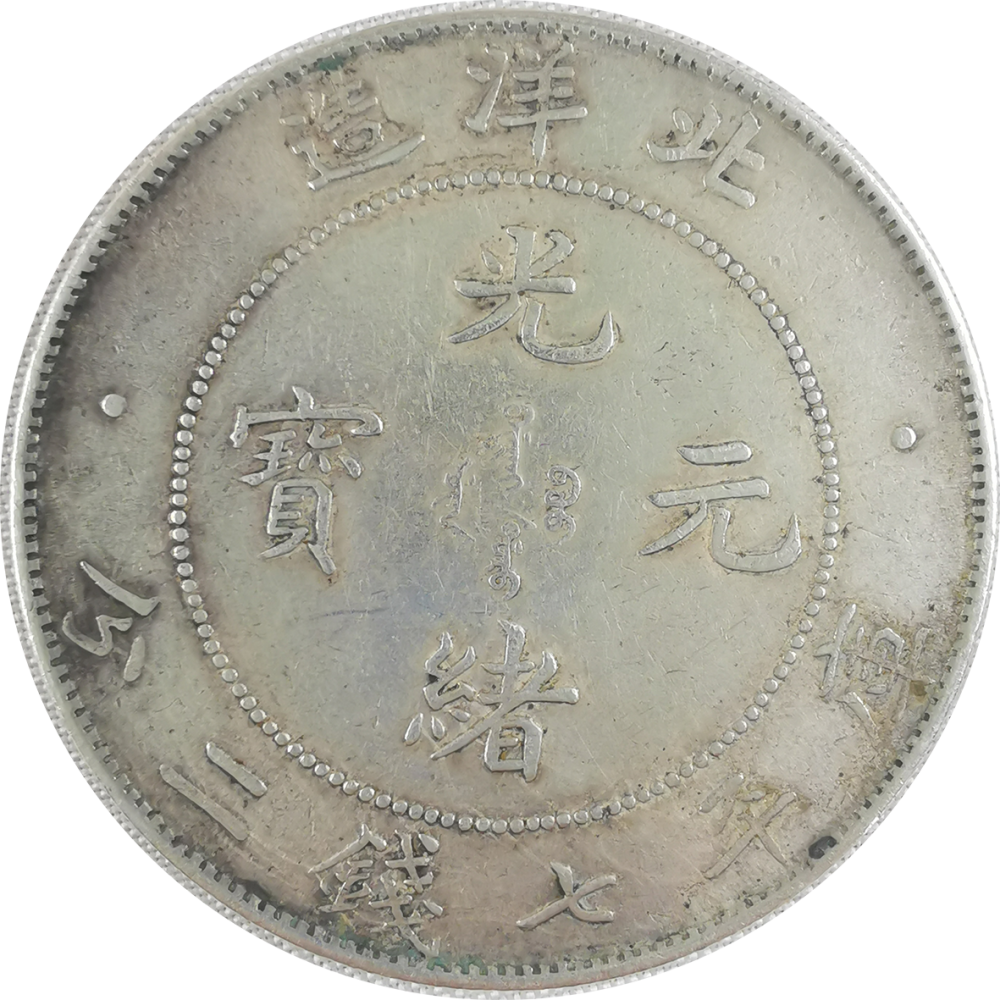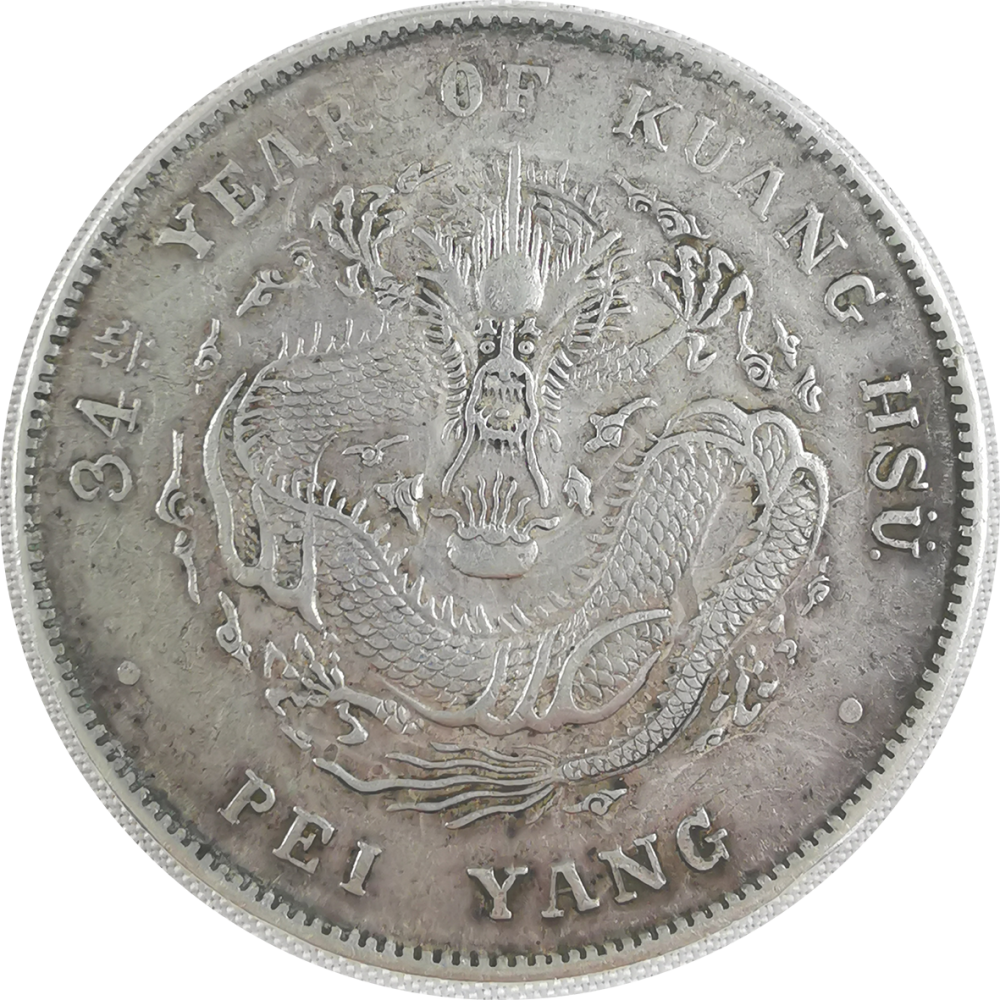【精品推荐】光绪元宝北洋造

光绪三十四年北洋造光绪元宝库平七钱二分银币系光绪34年(1908年)北洋银元局(旧称北洋机器局)铸行。银币正面中央珠圈内镌满汉文“光绪元宝”四个字,珠圈外上端镌汉文“北洋造”,下端镌汉文币值“库平七钱二分”,左右两端各镌一个圆点。银币背面中央镌蟠龙图,上环镌英文“光绪34年”下镌英文“北洋”,左右两端稍下侧各镌一个圆点。光绪元宝是清朝光绪年间流通的货币之一。共有十九个省局铸造,除中央户部,地方省所铸铜元。是首批引进海外技术的印发流通货币,对于现今也蕴藏了一定历史意义。
The Guangxu Yuan in the 34th year of Guangxu dynasty was made by the Beiyang Silver Dollar Bureau (formerly known as the Beiyang Machine Bureau) in the 34th year of Guangxu Dynasty (1908). The central bead ring on the obverse side of the silver coin engraved with the Chinese characters "Guangxu yuan Bao", the upper end of the bead ring engraved with the Chinese words "Made in beiyang", the lower end engraved with the Chinese currency "Kuping seven qian two", and the left and right ends each engraved with a spot. Silver coin back engraved panlong drawing in the center, the upper ring engraved English "Guangxu 34 years" engraved English "Beiyang", the left and right ends slightly lower side each engraved a dot. Guangxu yuan Bao was one of the COINS circulated during the Reign of Emperor Guangxu of the Qing Dynasty. A total of 19 provincial bureau casting, in addition to the central ministry, the local province casting copper yuan. It was one of the first to introduce overseas technology to print and circulate currency, which also has some historical significance for today.
“光绪元宝”是中国早的机制币,是中国近代机制币中的十大名誉品之一,俗称“龙洋”,因钱币背面一般铸有龙纹而得名。其具有重要的现实意义和历史意义,且加上清末、民国战乱连连等因素,一些较珍贵的光绪元宝银元品种存世量已稀少,收藏价值高。许多收藏家对它趋之若鹜,争相起价.北洋的银元发展历程映衬着中国晚清货币政策的进与退,每一次断档也刻录着一次历史的颠簸。了解造币史和造币厂的变迁过程,不仅可以理解银元的历史价值,同时也会对不同时期银元的种类、成色、龙纹特征、齿边特征等方面提高认知。
"Guangxu yuan Bao" is one of the earliest mechanism COINS in China. It is one of the top ten honorary COINS in modern Mechanism COINS of China, commonly known as "Longyang". It is named after the dragon pattern on the back of the coin. It has important practical and historical significance, and coupled with the late Qing Dynasty, the Republic of China repeatedly war and other factors, some of the more precious Guangxu silver varieties have been rare in the world, the collection value is high. Many collectors are flocking to it and bidding for it. The development course of beiyang silver dollar reflected the advance and retreat of China's monetary policy in the late Qing Dynasty, and each break also recorded a historical turbulence. Understanding the history of coinage and the changing process of the mint can not only understand the historical value of the silver, but also improve the cognition of the types, fineness, dragon pattern and tooth edge characteristics of the silver in different periods.
光绪元宝是清朝光绪年间流通的货币之一。由湖北两广总督张之洞率先引进英国铸币机器铸造银元和铜元,之后各省纷纷仿效。共有十九个省局铸造,除中央户部,地方省所铸铜元,皆在其正面上缘镌写省名。1793年首次在西藏铸行“乾隆宝藏”银币。1821年到1850年年间,台湾福建等地也曾仿制银圆,称为银饼。1890年开始正式铸造银元“光绪元宝”(即龙洋),各省纷起效尤。民国时期建立银本位货币制度以后,也以银元作为主要流通币。“光绪元宝”当时共十九个省局铸造。除中央户部,地方省所铸铜元,皆在其正面上缘镌写省名。计有:1户部;2北洋;3吉林;4奉天;5清江;6浙江;7江南;8广东;9山东;10福建;11湖南;12湖北;13四川;14江西;15河南;16安徽;17广西;18新疆;19黑龙江。
Guangxu yuan Bao was one of the COINS circulated during the Reign of Emperor Guangxu of the Qing Dynasty. Zhang Zhidong, governor of Hubei province and Guangdong Province, took the lead in introducing British coinage machines to cast silver and copper COINS, which were then followed by other provinces. A total of 19 provincial bureau casting, except the central ministry of households, the local province of the cast copper yuan, all engraved on the front edge of the province name. The Qianlong Treasure silver coin was first cast in Tibet in 1793. Between 1821 and 1850, Taiwan and Fujian provinces also imitated silver circles, known as silver cakes. In 1890 began the formal casting of silver "Guangxu yuan" (that is, longyang), the provinces followed suit. After the establishment of the silver standard currency system in the Republic of China, the silver dollar was also used as the main currency. "Guangxu yuan Bao" at that time a total of 19 provincial bureau cast. In addition to the central ministry of households, the local province of the copper COINS, are engraved on the front edge of the province name. There are: 1 household department; 2 the northern; 3 jilin; 4 Mukden; 5 qingjiang; Zhejiang; 7 jiangnan; Guangdong; 9 shandong; 10 in fujian province; Hunan; Hubei province; Sichuan; Jiangxi province; 15 in henan; Anhui; 17 guangxi; Xinjiang; Heilongjiang.
据了解,钱币收藏一般分为纸币、金银纪念币和古钱币三大类,而古钱币中银元一直是一大热点。因为银元材质珍贵,艺术价值高。北洋机器局初铸银元是在光绪十五年,面值仅“一元”一种,是天津官造的呈样银币,未流通,直至光绪二十二年,始铸流通银币。“大清光绪二十二年北洋机器局造”,面值有“一元”、“五角”、“两角”、“一角”、“半角”五种。是中国套以元为单位的计值银币。公元1903年7月,提出银币专由造币总厂制造,保留南洋(江南)、北洋、广东、湖北四局为分厂。银币材质珍贵,艺术价值高,由贵重金属或白银合金铸造,制作精美,图案考究,文字清秀,内容丰富,银光灿烂,其貌可人。
It is understood that the coin collection is generally divided into banknotes, gold and silver commemorative COINS and ancient COINS, of which silver has always been a hot spot. Because silver material precious, high artistic value. The first silver COINS of Beiyang Machinery Bureau were made in the fifteenth year of Guangxu Dynasty, with a face value of only "1 yuan". They were sample silver COINS made by tianjin government officials, but they were not in circulation until the 22nd year of Guangxu Dynasty. "Made by Beiyang Machine Bureau in the 22nd year of Guangxu emperor in qing Dynasty", the face value includes five kinds: "one yuan", "five jiao", "two jiao", "one jiao" and "half jiao". It is a set of Chinese silver COINS in yuan. In July 1903, it was proposed that the silver COINS should be made exclusively by the coinage general factory, and the four bureaus of Nanyang (South of the Yangtze River), Beiyang, Guangdong and Hubei were retained as branch factories. The silver coin is made of precious material and of high artistic value. It is made of precious metal or silver alloy. It is exquisitely made with exquisite designs, beautiful words, rich content and brilliant silver light.


此枚北洋造光绪元宝为34年版。银币正面中央珠圈内镌满汉文“光绪元宝”四字,珠圈外上端镌汉文“北洋造”,下端镌币值“库平七钱二分”,左右两端各镌一个圆点。银币背面中央镌蟠龙图,上环镌英文“光绪34年”,下镌英文“北洋”,左右两端稍下侧各镌一个圆点。此北洋造光绪元宝保存完好,包浆自然,做工精致,品相上乘。文字鼓凸,笔划纹饰滚圆深竣,楷书文字书法极为端庄大气,间架结构平衡舒展。蟠龙图案,眼神灵异炯炯有神,龙鳞排列细密有致且珍珠纹粒粒无虚无粘,龙爪张扬,遒劲有力。边齿标准,圈齿凸起,颗粒清晰,地章平整,光滑如板。
This beiyang Guangxu yuan is 34 years edition. The central bead ring on the obverse side of the coin engraved with the Chinese character "Guangxu yuan Bao", the upper end of the bead ring engraved with the Chinese character "Made in beiyang", the lower end engraved with the value "Kuping seven qian two", and the left and right ends each engraved with a spot. Silver coin on the back of the central Juan Panlong diagram, the upper ring Juan English "Guangxu 34 years", the lower Juan English "Beiyang", the left and right ends slightly lower side each Juan a dot. This beiyang guangxu ingot is well preserved, natural pulp, exquisite workmanship, excellent quality. The characters are convex, the strokes are deep and round, the regular script calligraphy is very dignified atmosphere, the structure of the balance stretch. Flat dragon design, eyes twinkling, dragon scales arranged finely and pearl grain particles without nihility, dragon claws make public, vigorous and powerful. Side teeth standard, ring teeth protruding, grain clear, flat, smooth as plate.
藏品的品相精美,其审美个性独持,钱币正面鲜然可见满汉文化的交融,而钱背却清晰标明了西方文化的介入。其包浆入骨,熟旧天然,深打字口明白,流转痕迹显着,边齿过关,龙鳞清晰,具有极高的出资价值和保藏价值。它有着前史熏陶,是价值很高的革新文物,具有深远的前史留念含义;同时仍是考古和研讨我国前史文化可贵的什物.光绪元宝是清代光绪年间特有的一种钱银。有着清朝钱银特征,因为其时时局不稳定,因而几乎在全国的各个省都有专门的钱银锻造厂。因而我们会发现那个时代的钱银上都有明显的铸字,标明是哪个省的造币厂锻造的。
The pieces in the collection are exquisite and their aesthetic personality is unique. The fusion of Manchu and Han cultures can be seen on the front of the coin, while the back of the coin clearly indicates the involvement of Western culture. Its package pulp into bone, ripe old natural, deep typing mouth understand, circulation trace is significant, side teeth clearance, dragon scale clear, with high investment value and preservation value. It has the edification of pre-history, is the innovation cultural relic of high value, has the profound implication of pre-history; At the same time, it is still a valuable thing for archaeology and research of our pre-history and culture. Guangxu yuan Bao is a special kind of money and silver in The Guangxu Period of the Qing Dynasty. It has the characteristics of the Qing Dynasty. Because of the unstable situation at that time, there were special forges in almost every province of the country. As a result, we will find that the money and silver of that era have distinct inscriptions on them, indicating the mint in which province they were forged.









